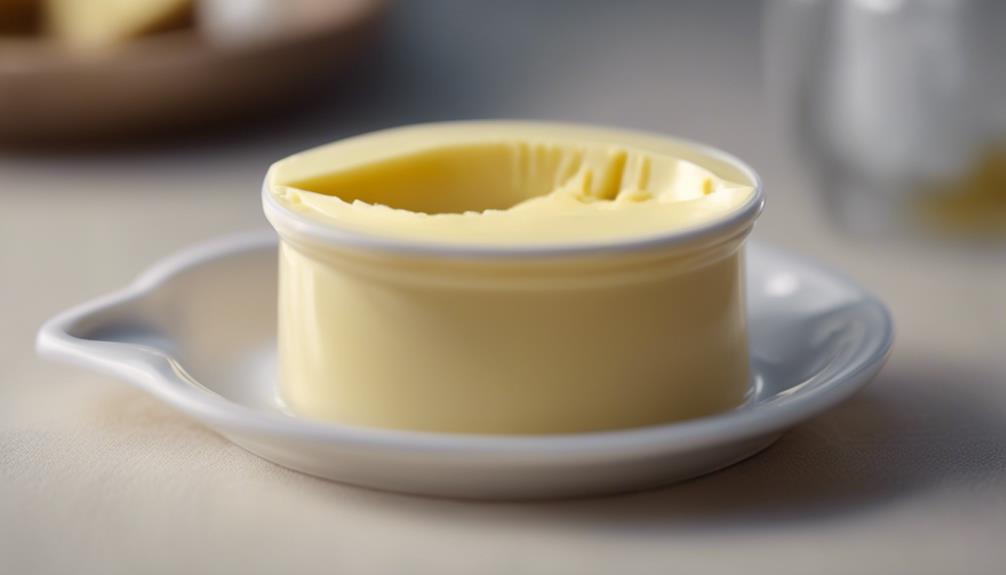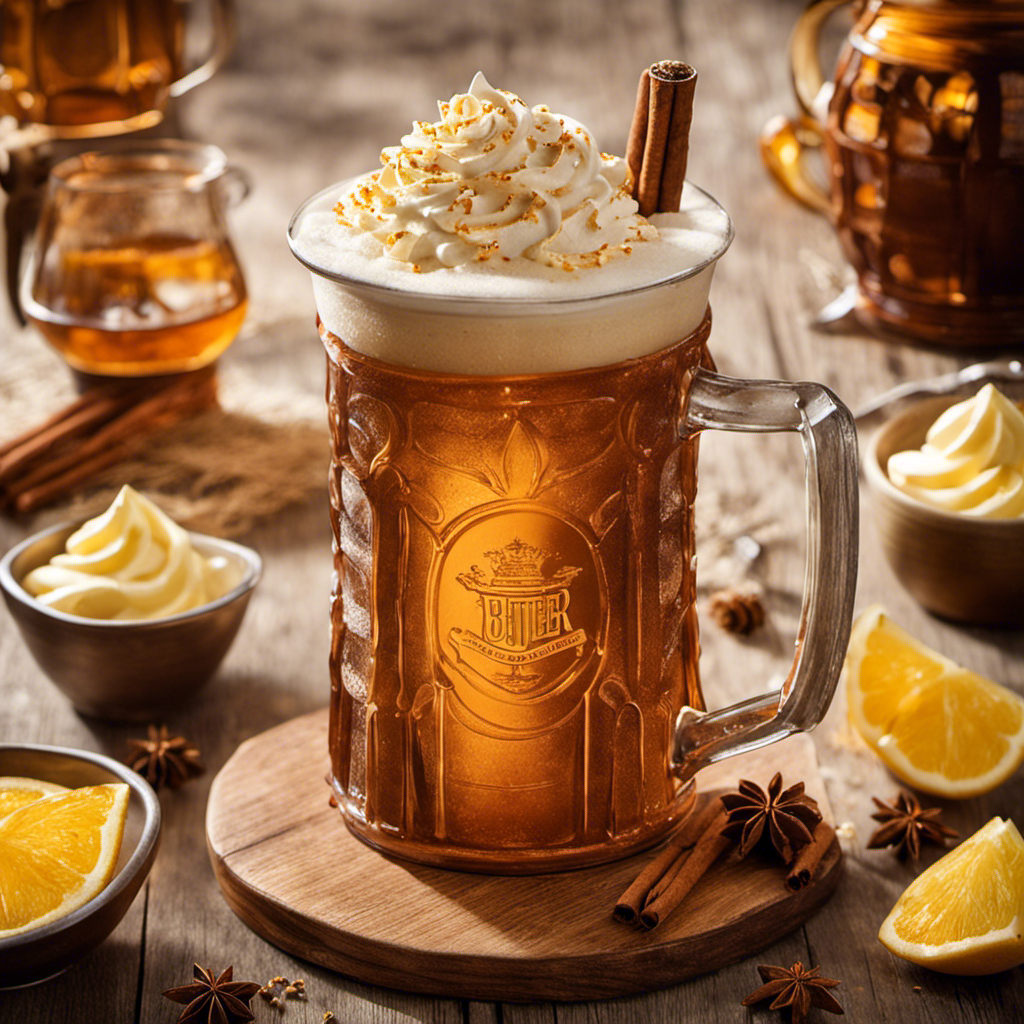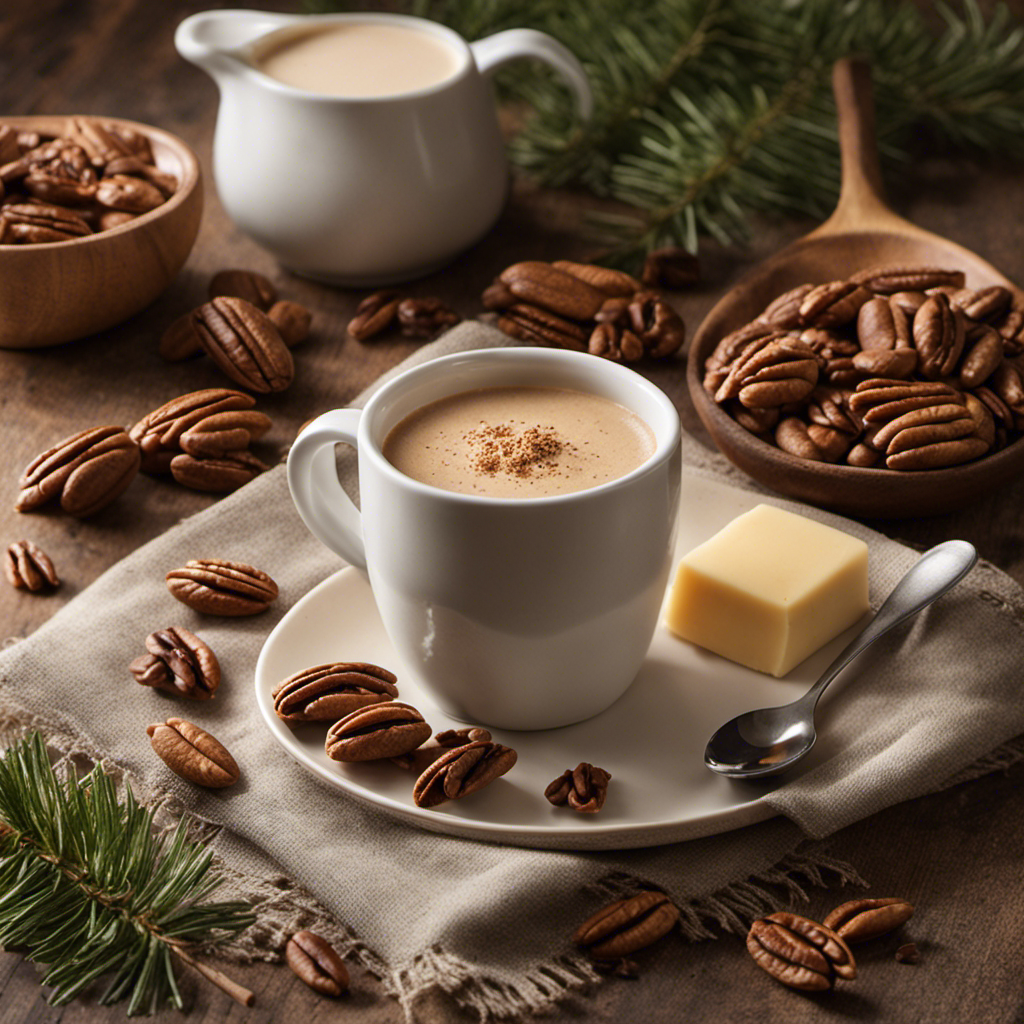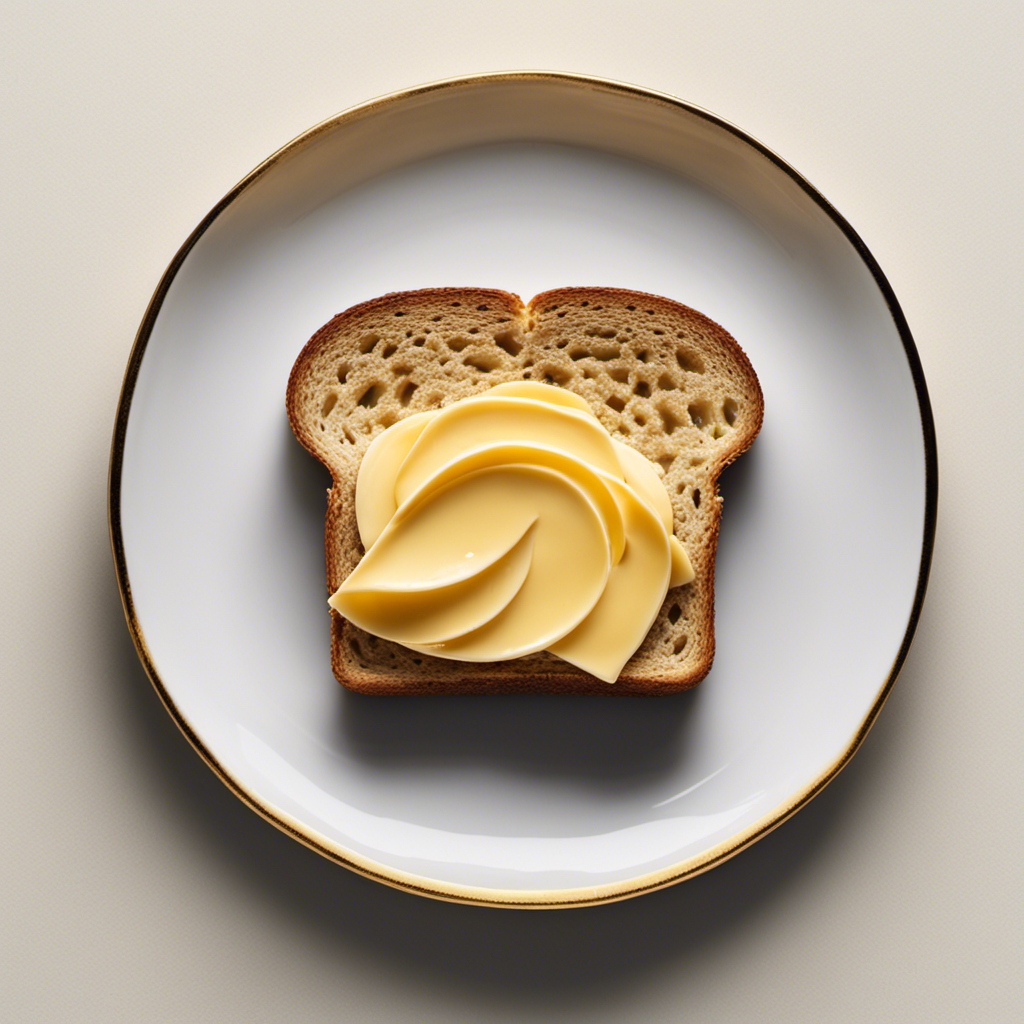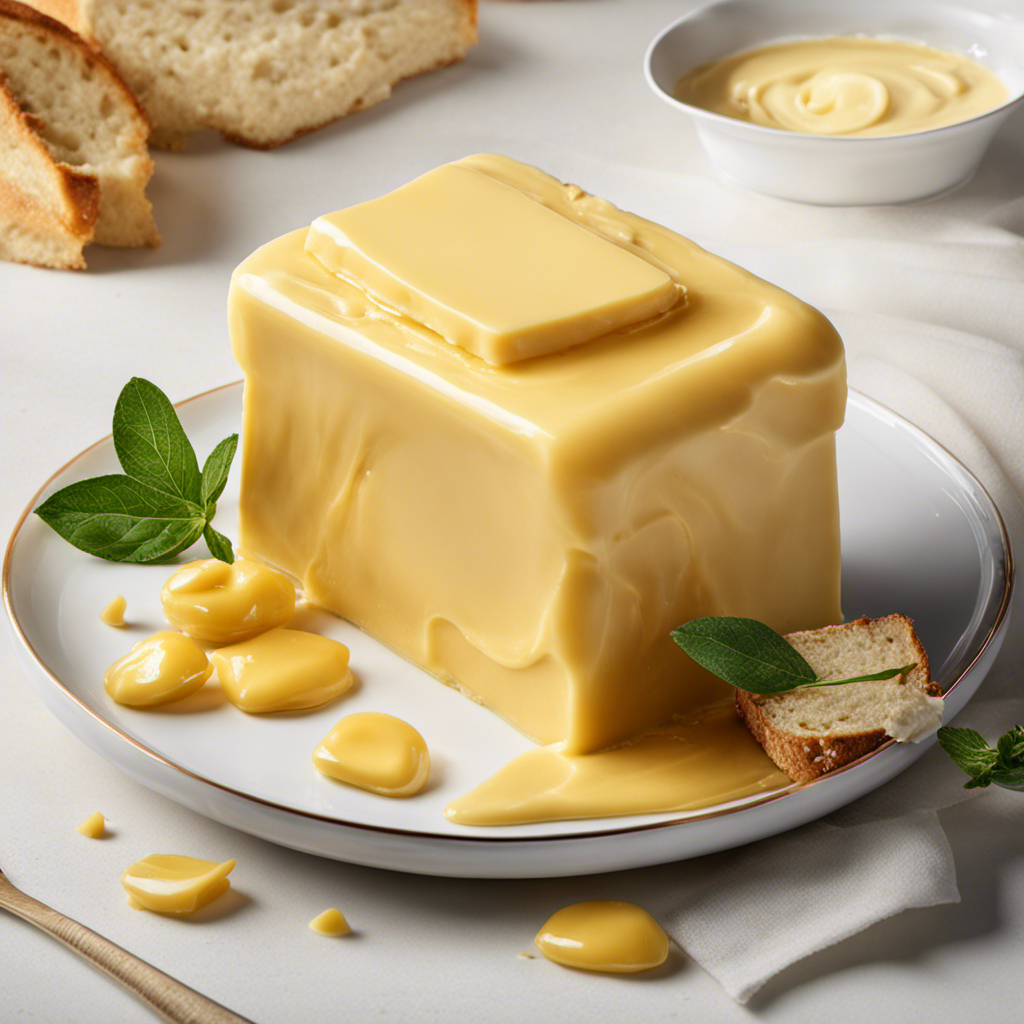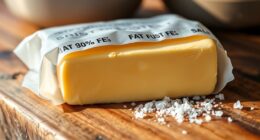If you're wondering how many tablespoons in half a cup of butter, it's simple: half a cup equals 8 tablespoons or 4 ounces. Understanding butter measurements can improve your cooking accuracy.
Key Takeaways
- Half a cup of butter is equivalent to 8 tablespoons or 4 ounces.
- A half cup of butter equals 1 stick or 1/4 pound.
- This measurement is crucial for precise recipe execution.
- Understanding butter equivalencies aids in efficient cooking.
- Butter packaging often includes measurements for easy reference.
Butter Stick Measurement
When measuring half a cup of butter in stick form, you can easily identify it as half of a standard 1/2 pound stick. This means that half a cup of butter is equivalent to 8 tablespoons or 4 ounces.
It's helpful to know that there are 8 tablespoons in one stick of butter, making it convenient for recipes that call for precise measurements. Butter sticks are a common unit of measurement in cooking and baking, with each tablespoon of butter weighing around 0.5 ounces or 14 grams.
These measurements are often marked on the packaging of butter sticks, allowing for quick and easy reference when following recipes. Understanding the relationship between tablespoons and sticks of butter can streamline your cooking process and guarantee accurate measurements in your dishes.
Next, we'll explore how many sticks are in one cup of butter to further enhance your recipe knowledge.
Sticks in One Cup of Butter
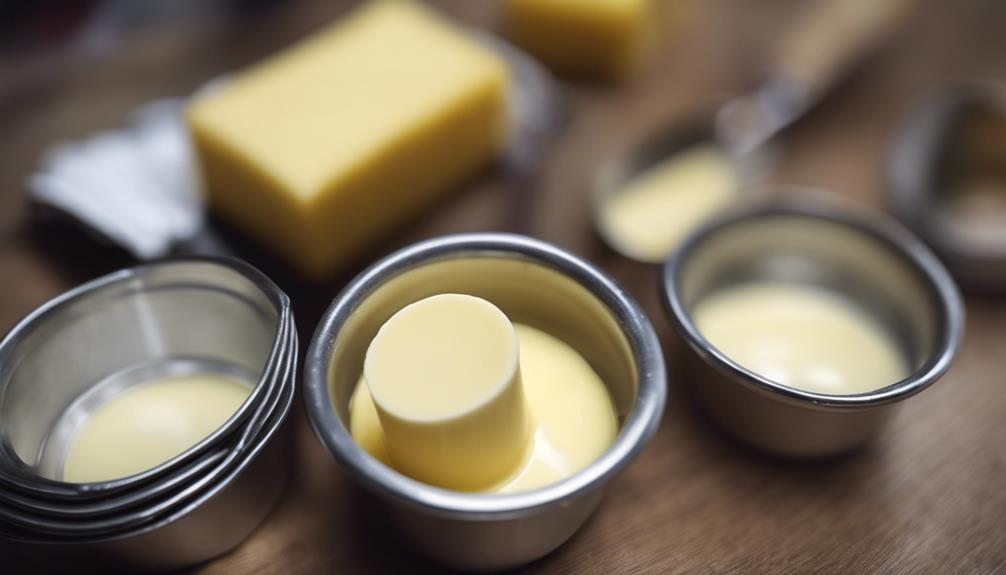
To comprehend the composition of a cup of butter, consider that it consists of two standard sticks, each equivalent to half a cup. This means that one cup of butter is made up of two butter sticks.
These sticks are conveniently marked for measurement, with tablespoon and cup increments labeled on the packaging. When a recipe calls for one cup of butter, you'll need two of these butter sticks.
Knowing that one cup equals two sticks of butter can be helpful when preparing your ingredients. It simplifies the process of measuring out the required amount, especially when following recipes that specify butter in stick measurements.
Measuring One Cup of Butter
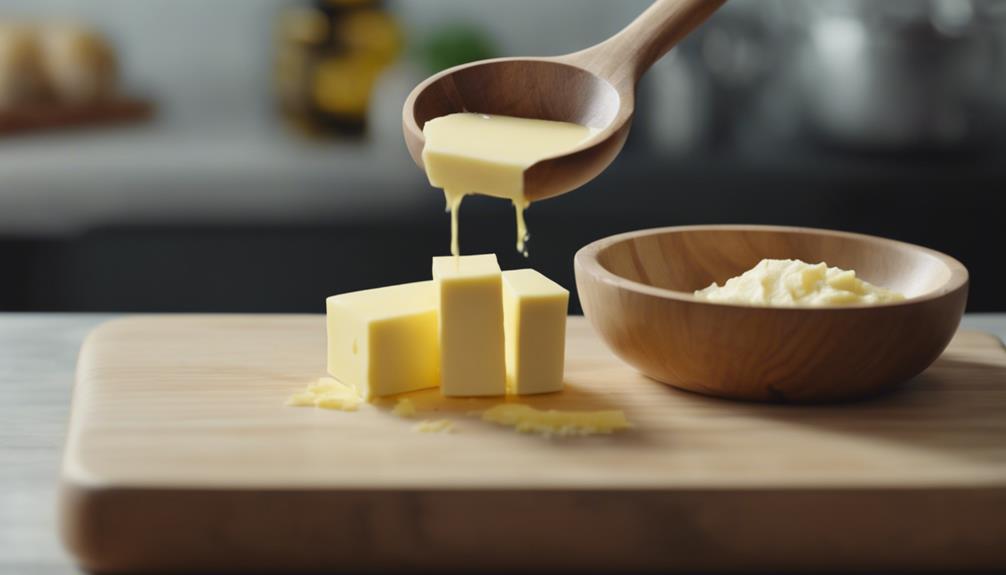
Measuring one cup of butter accurately requires understanding its equivalent measurements in tablespoons and ounces. When you measure butter, keep in mind that one cup equals 16 tablespoons or 8 ounces in weight. This information is vital for properly portioning out the amount of butter needed for your recipes.
Whether you're using a measuring cup or weighing scale, knowing these conversions guarantees you add the right amount of butter for the best results in your cooking or baking.
Using tablespoons to measure butter is a common practice in the kitchen. Each tablespoon represents a specific portion of butter, making it easier to measure out one cup accurately. By knowing that one cup is equivalent to 16 tablespoons, you can quickly measure out the butter needed without any guesswork.
For precise and consistent results in your recipes, mastering how to measure butter accurately is crucial. Remember, one cup of butter equals 16 tablespoons or 8 ounces, providing a reliable reference point for your cooking endeavors.
Butter Measurements Conversion Chart
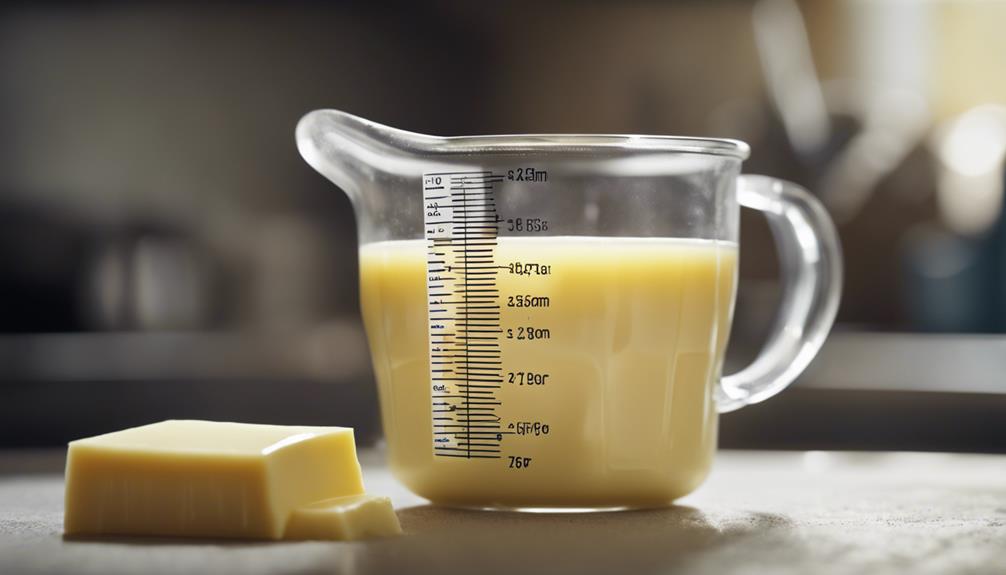
Let's break down the Butter Measurements Conversion Chart.
You'll learn about the various equivalents for a stick of butter and how to measure butter accurately in recipes.
This information will help you navigate your way through baking and cooking with ease.
Butter Measurements Overview
When measuring butter for your recipes, it's helpful to keep in mind that a stick of butter equals 8 tablespoons or 1/2 cup in American cooking measurements. Butter sticks, typically weighing around 4 ounces or 113 grams, are a convenient way to portion butter for your cooking and baking needs.
Butter can be measured not only in sticks but also in cups, tablespoons, or grams, depending on the recipe's requirements. In European recipes, butter measurements are often specified in grams for more precise accuracy.
The shape of butter sticks plays a pivotal role in easy measuring and accurate portioning. The pre-marked tablespoon lines on the butter wrapper make it simple to slice off the required amount without the need for additional measuring tools. This standardization in butter packaging allows for effortless incorporation into various recipes while ensuring consistent results.
Next time you're preparing a recipe that calls for butter, remember the convenience of using butter sticks for a hassle-free measuring experience.
Stick of Butter Equivalents
The Butter Measurements Conversion Chart provides a quick reference for easily converting between stick equivalents and other common measurements used in recipes.
When dealing with butter, understanding the equivalencies can make your cooking and baking experiences much smoother. Here are some key points to keep in mind:
- A stick of butter equals 8 tablespoons or 1/2 cup.
- It also weighs approximately 4 ounces or 113 grams.
- The convenience of using butter in sticks lies in its standardized measurements, making it easier to follow recipes accurately.
Knowing that a stick of butter is equivalent to 8 tablespoons can help you quickly measure out the right amount for your recipe. Whether you're melting it down or using it in its solid form, this simple conversion can save you time and effort in the kitchen.
Measuring Butter Accurately
To accurately measure butter in your recipes, refer to the Butter Measurements Conversion Chart for precise equivalents in sticks, cups, tablespoons, and grams.
When it comes to baking or cooking, it's crucial to properly measure butter in tablespoons to make sure your dish turns out as intended. Remember, one stick of butter is equal to 8 tablespoons or 1/2 cup. This measurement is vital for various recipes, as the right amount of butter can greatly impact the texture and flavor of your final product.
Additionally, knowing that one stick of butter weighs around 4 ounces or 113 grams can help you measure accurately if you don't have a scale on hand. Many butter blocks are conveniently labeled with measurements, making it simpler for you to portion out the precise amount needed for your culinary creations.
How Much Is 1 Stick of Butter?

If you're wondering how much 1 stick of butter is, it's equivalent to:
- 1/2 cup
- 8 tablespoons
- 113 grams
Knowing this helps you accurately measure butter in recipes and achieve consistent results in your cooking and baking.
Understanding butter stick measurements, quantity equivalents, and conversion charts is key for culinary success.
Butter Stick Measurements
Learn the exact measurement of one stick of butter to guarantee precision in your recipes.
Understanding butter measurements is essential for achieving the perfect texture and flavor in your baked goods and dishes.
Here are some key points to keep in mind when using one stick of butter:
- One stick of butter is equivalent to 1/4 of a standard 1-pound block, weighing 4 ounces or 113 grams.
- A stick of butter measures 8 tablespoons or 1/2 cup in volume, making it easy to portion out for your recipes.
- Butter sticks are conveniently marked in tablespoons, simplifying the process of measuring the right amount for your cooking needs.
Butter Quantity Equivalents
Understanding how much butter is in one stick can simplify your recipe preparation and guarantee accurate measurements for successful cooking and baking endeavors. A stick of butter is equivalent to 8 tablespoons or 1/2 cup, weighing about 4 ounces or approximately 113 grams. Butter sticks are conveniently marked for easy measurement in recipes, with two sticks making up one cup in most recipes. Here is a visual representation of butter quantity equivalents:
| Butter Quantity | Equivalent Measurements |
|---|---|
| 1 Stick | 8 tablespoons or 1/2 cup |
| 2 Sticks | 1 cup |
| 1 Stick (Weight) | 4 ounces or 113 grams |
| 1 Cup | 16 tablespoons |
| 1 Pound (4 sticks) | 2 cups or 32 tablespoons |
Using butter sticks to measure can streamline your cooking process, ensuring you add the right amount for delicious results in your culinary creations.
Butter Conversion Chart
Discovering the equivalent measurements of one stick of butter can simplify your cooking and baking endeavors. When you understand how much butter is in one stick, it becomes easier to follow recipes accurately and achieve delicious results.
Here are some key facts about the conversion of one stick of butter:
- One stick of butter is equal to 8 tablespoons or 1/2 cup, making it a versatile unit of measurement in the kitchen.
- A standard stick of butter weighs around 4 ounces or approximately 113 grams, providing a convenient way to measure butter for various recipes.
- Butter sticks are commonly sold pre-packaged with measurements marked on the wrapper, allowing for easy conversion to tablespoons or cups for your convenience.
Next time you need to use melted butter or measure out a specific quantity of butter for your culinary creations, knowing the conversion of one stick of butter will make your cooking experience much more efficient.
Measuring Butter From Sticks
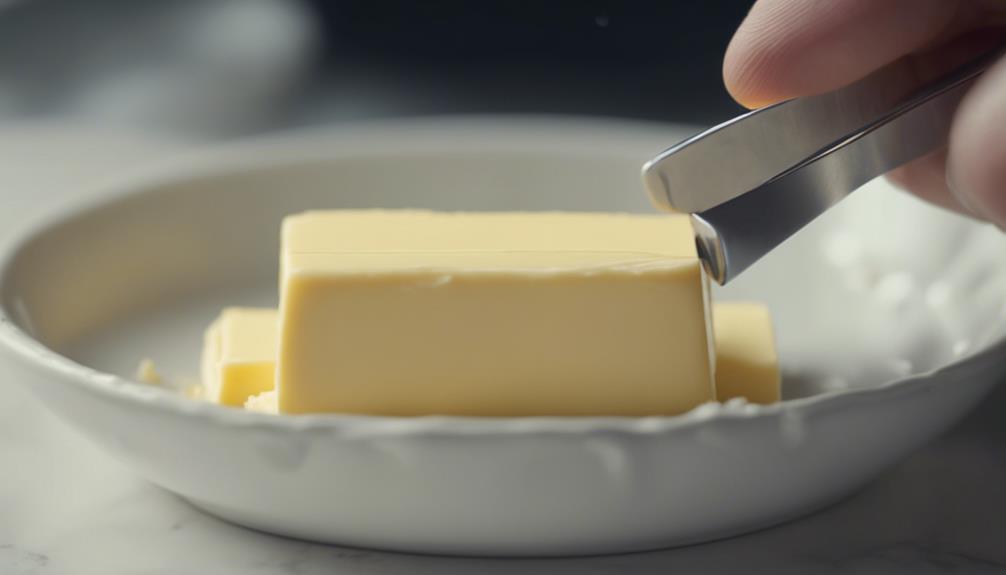
When measuring butter from sticks, make certain that one stick equals half a cup, simplifying your recipe preparation. This knowledge is essential when your recipe calls for a specific amount of butter. Understanding that a half a cup of butter is equivalent to 1 stick or 4 tablespoons can help you measure the right amount accurately. This is particularly vital for baking and cooking, where precision can greatly impact the final outcome of your dish.
To make sure you're using the correct amount of butter, consider using measuring tools like a kitchen scale. Measuring by weight can be more accurate than using volume measurements, especially when dealing with ingredients like butter that can easily be compacted or vary in density.
Butter by Tablespoons (Tbsp.)
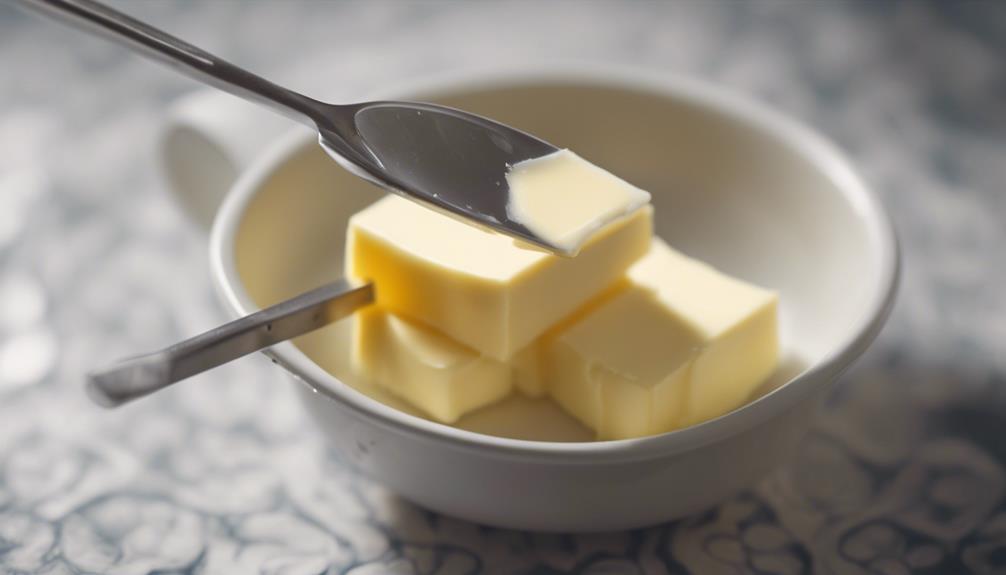
To measure butter by tablespoons (Tbsp.), simply remember that half a cup of butter equals 8 tablespoons or 1/4 pound. When working with a recipe that calls for half a cup of butter, it's necessary to know the tablespoon equivalent to guarantee your dish turns out just right. Here are some key points to keep in mind:
- A half cup of butter is equal to 8 tablespoons or 1/4 pound, providing a handy way to measure butter for various recipes.
- Measuring half a cup of butter in tablespoons is also equal to 120 milliliters, which can be helpful when dealing with metric measurements.
- When a recipe specifies half a cup of butter, it usually means using 1 stick of butter, simplifying the measurement process for many home cooks.
Understanding the tablespoon measurement of half a cup of butter is important for precise and accurate cooking, ensuring your dishes are consistently delightful.
Frequently Asked Questions
Does 1 Stick of Butter Equal a Half Cup?
Yes, 1 stick of butter equals a half cup. You can measure half a cup of butter using 8 tablespoons or half a standard stick. Knowing this simplifies your cooking and baking measurements, making it easier to follow recipes accurately.
How Do You Measure Half a Cup of Butter?
When measuring half a cup of butter, simply cut a stick in half or use 8 tablespoons. Follow marked measurements on a butter wrapper or weigh around 113 grams. It's easy to measure accurately for your recipes!
How Many 1/4 Sticks of Butter Make a Cup?
To make a cup of butter, you need four 1/4 sticks. Each 1/4 stick equals 2 tablespoons or 1/8 cup. Knowing this helps you accurately measure butter for your recipes. Keep this in mind for baking!
Is 10 Tablespoons Half a Cup?
You're close, but not quite there. Ten tablespoons may seem like half a cup of butter, but it's actually eight tablespoons. Getting the right amount is key for your baking and cooking endeavors.
Conclusion
Now that you know how many tablespoons are in a half a cup of butter, you can confidently whip up your favorite recipes with ease.
Butter may seem simple, but it truly is a versatile ingredient that adds richness and depth to dishes.
So go ahead, measure out that butter and let your creativity in the kitchen shine like a golden stick of butter melting in a warm pan.
Happy cooking!
